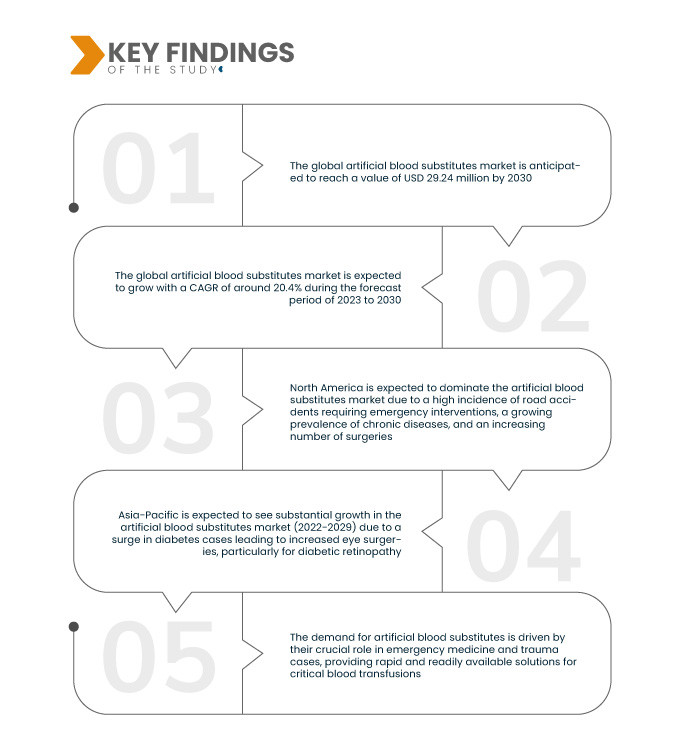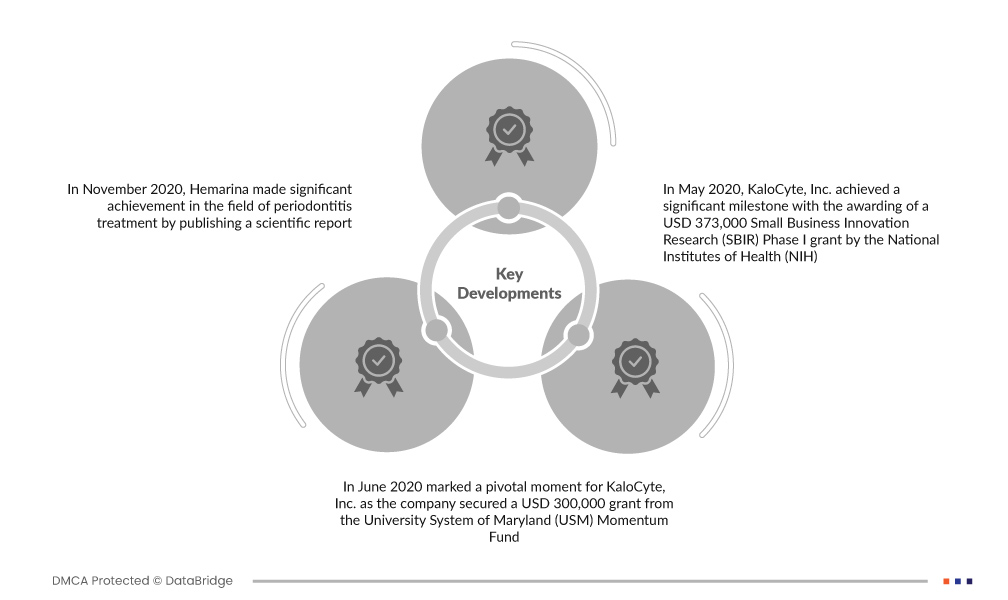The importance of artificial blood substitutes lies in their ability to enhance oxygen transport, mimicking the crucial function of natural blood. Designed to replicate the oxygen-carrying capacity of red blood cells, these substitutes prove invaluable in situations where oxygen delivery is compromised. In surgical procedures, critical care, and emergency scenarios, artificial blood substitutes ensure that vital organs and tissues receive adequate oxygen. This capability is especially significant in blood shortages, trauma, or complex surgeries, where traditional blood transfusions may be limited or impractical. By optimizing oxygen transport, artificial blood substitutes contribute to improved patient outcomes and expanded treatment options in diverse medical contexts.
Access Full Report @ https://www.databridgemarketresearch.com/reports/global-artificial-blood-substitutes-market
Data Bridge Market Research analyses the Global Artificial Blood Substitutes Market, which was USD 6.67 million in 2022, is expected to reach USD 29.24 million by 2030, and is likely to undergo a CAGR of 20.4% from 2023 to 2030. The shortage of donor blood, combined with rising demand, is a driving force in the artificial blood substitute market. As traditional blood donation systems face limitations, these substitutes emerge as a promising solution, providing an alternative means to meet the increasing demand for transfusions in various medical scenarios.
Key Findings of the Study
Increasing innovations in biotechnology and ongoing medical research are expected to drive the market's growth rate
Innovations in biotechnology and ongoing medical research are prominent drivers for the artificial blood substitutes market. Continuous advancements in these fields lead to the development of more sophisticated and effective substitutes. Researchers explore novel formulations and technologies, improving artificial blood substitutes' safety, efficacy, and applicability across diverse medical scenarios. This driver underscores the dynamic nature of the market, as cutting-edge discoveries and breakthroughs fuel the evolution of artificial blood substitutes, making them increasingly reliable and versatile for a range of healthcare applications.
Report Scope and Market Segmentation
|
Report Metric
|
Details
|
|
Forecast Period
|
2023 to 2030
|
|
Base Year
|
2022
|
|
Historic Years
|
2021 (Customizable to 2015-2020)
|
|
Quantitative Units
|
Revenue in USD Million, Volumes in Units, Pricing in USD
|
|
Segments Covered
|
Product Type (Perflurocarbon (PFCs), Hemoglobin-Based Oxygen Carries (HBOCs)), Source (Human Blood, Animal Blood, Microorganism Based Recombinant HB, Synthetic Polymers, Stem Cells), Application (Cardiovascular Diseases, Malignant Neoplasma, Injuries, Neonatal Conditions, Organ Transplant, Maternal Condition), End-User (Hospital and Clinics, Blood Banks, Others)
|
|
Countries Covered
|
U.S., Canada and Mexico in North America, Germany, France, U.K., Netherlands, Switzerland, Belgium, Russia, Italy, Spain, Turkey, Rest of Europe in Europe, China, Japan, India, South Korea, Singapore, Malaysia, Australia, Thailand, Indonesia, Philippines, Rest of Asia-Pacific, Saudi Arabia, U.A.E, South Africa, Egypt, Israel, Rest of Middle East and Africa, Brazil, Argentina and Rest of South America
|
|
Market Players Covered
|
Aurum Biosciences (U.K.), HEMARINA (France), Hemoglobin Oxygen Therapeutics LLC (U.S.), KaloCyte Inc. (U.S.), SpheriTech Ltd. (U.K.), Centrum Medyczne VisusMed (Poland), European Medicines Agency (Netherlands), OPK Biotech Inc. (U.S.), NuvOx Pharma (U.S.), Prolong Pharmaceuticals, LLC (U.S.), Boston Pharmaceuticals (U.S.), OXYVITA Inc (U.S.), NanoBlood LLC (U.S.)
|
|
Data Points Covered in the Report
|
In addition to the insights on market scenarios such as market value, growth rate, segmentation, geographical coverage, and major players, the market reports curated by the Data Bridge Market Research also include depth expert analysis, patient epidemiology, pipeline analysis, pricing analysis, and regulatory framework.
|
Segment Analysis:
The global artificial blood substitutes market is segmented on the basis of product type, source, application, and end-user.
- On the basis of product type, the global artificial blood substitutes market is segmented into perflurocarbon (PFCs), and hemoglobin-based oxygen carries (HBOCs)
- On the basis of source, the global artificial blood substitutes market is segmented into human blood, animal blood, microorganism based recombinant HB, synthetic polymers, and stem cells
- On the basis of application, the global artificial blood substitutes market is segmented into cardiovascular diseases, malignant neoplasma, injuries, neonatal conditions, organ transplant, and maternal condition
- On the basis of end-user, the global artificial blood substitutes market is segmented into hospital and clinics, blood banks, and others
Major Players
Data Bridge Market Research recognizes the following companies as the major global artificial blood substitutes market players in global artificial blood substitutes market are Aurum Biosciences (U.K.), HEMARINA (France), Hemoglobin Oxygen Therapeutics LLC (U.S.), KaloCyte Inc. (U.S.), SpheriTech Ltd. (U.K.), Centrum Medyczne VisusMed (Poland), European Medicines Agency (Netherlands), OPK Biotech Inc. (U.S.)
Market Developments
- In November 2020, Hemarina made significant strides in the field of periodontitis treatment by publishing a scientific report. The report focused on the anti-inflammatory and antibacterial properties of M 101; an oxygen transporter derived from marine lugworm haemoglobin. The study not only validated the quality of the M 101 molecule but also highlighted its potential as a promising therapeutic agent for periodontitis
- In June 2020 marked a pivotal moment for KaloCyte, Inc. as the company secured a USD 300,000 grant from the University System of Maryland (USM) Momentum Fund. This funding injection was specifically allocated for the development of ErythroMer, a synthetic, bio-inspired red blood substitute. Thanks to this financial support, KaloCyte, Inc. was able to expedite the progress of ErythroMer, bringing them closer to potentially revolutionizing the field of blood substitutes
- In May 2020, KaloCyte, Inc. achieved a significant milestone with the awarding of a USD 373,000 Small Business Innovation Research (SBIR) Phase I grant by the National Institutes of Health (NIH). This grant played a crucial role in advancing the KaloCyte product to preclinical safety and efficacy testing, setting the stage for its eventual market launch. The financial backing from NIH underscored the potential of KaloCyte's innovative approach and contributed to the progression of their product towards regulatory approval and commercialization
Regional Analysis
Geographically, the countries covered in the global artificial blood substitutes market report are U.S., Canada and Mexico in North America, Germany, France, U.K., Netherlands, Switzerland, Belgium, Russia, Italy, Spain, Turkey, Rest of Europe in Europe, China, Japan, India, South Korea, Singapore, Malaysia, Australia, Thailand, Indonesia, Philippines, Rest of Asia-Pacific, Saudi Arabia, U.A.E, South Africa, Egypt, Israel, Rest of Middle East and Africa, Brazil, Argentina and Rest of South America.
As per Data Bridge Market Research analysis:
North America is the dominant region in the global artificial blood substitutes market during the forecast period 2023-2030
North America dominates the artificial blood substitutes market due to various factors. The region's high incidence of road accidents necessitates advanced medical interventions, and artificial blood substitutes offer a crucial solution for emergency trauma cases. The rising prevalence of chronic diseases, such as cardiovascular disorders, aligns with the adaptability of artificial blood substitutes, providing an alternative to traditional transfusions. The increasing number of surgeries and an aging population further amplify the demand for blood substitutes in medical interventions.
Asia-Pacific is estimated to be the fastest-growing region in the global artificial blood substitutes market for the forecast period 2023-2030
Asia-Pacific is expected to experience significant growth in the artificial blood substitutes market from 2022 to 2029. This is primarily attributed to the region's escalating diabetes cases, leading to a surge in surgeries related to eye operations, specifically those addressing blindness caused by diabetic retinopathy. Artificial blood substitutes, particularly hemoglobin-based oxygen carriers (HBOCs), play a pivotal role in these surgeries by enhancing oxygen delivery. The tailored application of HBOCs to address prevalent healthcare challenges, such as diabetes-related complications, underscores the region's unique demands and positions artificial blood substitutes as vital contributors to advancing medical interventions in Asia-Pacific.
For more detailed information about the global artificial blood substitutes market report, click here – https://www.databridgemarketresearch.com/reports/global-artificial-blood-substitutes-market












